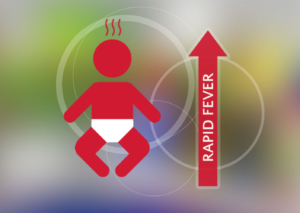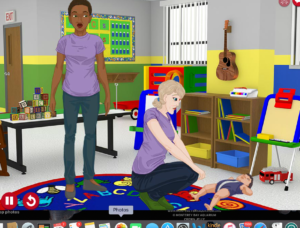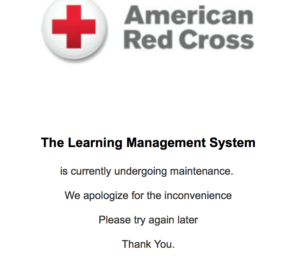Learning First Aid and CPR On a Laptop

Well, I WAS going to share with you what I’ve learned about pre-prepped food boxes delivered to your front door, but that will have to wait for next time. Instead, I’m going to write about my first experience with online safety training.
For three days I’ve been trying to complete an online First Aid and CPR class. When I first saw it in the Red Cross online class catalog, I thought it seemed like a good idea. Instead of spending a weekend at an in-person class away from home, I would read and respond to a series of increasingly challenging scenarios, working online to complete various “missions” that eventually culminated in completing the course and receiving a certificate.
I’ve been certified in both of these areas for many years. For twenty years I even taught the pediatric First Aid and CPR class at the college where I worked. I should know this stuff. However, when Bean was born my certification was still current, and after I retired, I let it lapse. With two new grand babies born this past spring and one more due in the fall, I thought it was time to update my skills.
Completing the class requirements in this way, and then just showing up for an hour of skills testing would be easy. And it would reassure both myself and my children that I was prepared to take care of any of my three new grandchildren whenever they asked.
Well, it wasn’t! Easy, that is. Come along on my journey.
Signing Up Is Easy
Signing up for the class was fairly straightforward; I just selected it from a list, paid the fee, and noted that I would have unlimited access to the online class until I completed all the “missions.” Also that I should show up at the local Red Cross office for an hour and fifteen minutes a few days hence, presumably to demonstrate my skills.
The estimated time for completion of the online portion of the course was 2 3/4 hours, and I would have the option of taking the final exam without completing all the lessons if I thought I could succeed. I had three days to complete this — how hard could it be?
It took me a while to figure out how to first launch the class; the web site threw up several windows in the process, and I finally found it about three layers down on my screen. However, once I opened it, I accidentally closed the window several times when I was working on it, losing my work so far. Each time I did this, it took me several tries to find the tiny word “launch” in the portion of the page that listed my section number and the title of my class.
 Eventually I got the hang of it, though, and I worked on several scenarios to completion, then left to do something else and come back for a while later. The scenarios were familiar to me, from years of Red Cross videos, and so were the basic steps we were taught — to survey a scene, ask for consent, call 911 and care for the child or adult in question.
Eventually I got the hang of it, though, and I worked on several scenarios to completion, then left to do something else and come back for a while later. The scenarios were familiar to me, from years of Red Cross videos, and so were the basic steps we were taught — to survey a scene, ask for consent, call 911 and care for the child or adult in question.
However, the mechanics of actually doing the skills, such as bandaging a bleeding wound, giving back blows, chest thrusts, or rescue breaths to a supine man, woman, child, or infant, depended in this online version on the flexibility of my fingers, and my agility with a track pad or mouse.
Over and over again I found myself picking up a graphic hand and trying to move it to the correct position on a man’s chest, only to have it fly back to the original spot again, costing me time on the clock and sometimes an automatic correction and lost points. Sometimes I would put my finger on the track pad on my laptop and a menu would pop up on the screen that I then needed to eliminate – a very annoying interruption.
The exact position of one’s knees when kneeling beside a child is shown by moving an arrow to the right or the left until the picture of the knees is in the correct place. The exact length of a rescue breath depends upon you placing the cursor on the picture of the victim’s mouth and holding the track pad or mouse button down for the correct amount of time before releasing it.
Between the coastal fog we’ve had in Santa Cruz this week and my normally crotchety arthritic hands, I could only do this focused hand work for half an hour or so at a time and then I needed to rest my joints.
Does this type of teaching work?
If I didn’t know anything about First Aid and CPR, I think this class is an effective way to learn the basics. Because the missions are skillfully designed to build on the previous knowledge and skills practiced, I did get gradually better at remembering the exact steps I needed to take as I moved through the class, from surveying a scene (now called Check, Call, Care), and handling such emergencies as bleeding, seizures, burns, and fainting, to breathing emergencies and cardiac arrest.
But the hands-on mechanical parts of the class, picking up pictures of the bandages and ties with a cursor and placing them on the bleeding arm; the repetitious cursor clicks and calibrated actions — I found those extremely challenging, and my many errors did not always reflect my knowledge, or the manual skills needed to perform the actions in a real life emergency.
I became more and more frustrated as I worked slowly through the scenarios, clocking up 2 hours, 4, 6, and still not finishing. I was on the third afternoon of my task when my daughter and Bean returned home from a vacation and came over for dinner. While the meal was cooking, I brought Bean into my study to show her the online class. It looked like a video game: she loved it. I went all the way through a scenario but didn’t pass it. We went through it together a second time. The third time she wanted to do some of the keyboard work. We counted together as she pressed the track pad down repeatedly to simulate 30 chest compressions and 2 rescue breaths, but she kept moving the cursor away from the two hands that were pressing down on the man’s chest. She tried several more times and got frustrated, so we moved to another game.
However, she wanted to come back again later, and she watched me as I completed a different scenario, this time one with a child. She was fascinated by the made-up situations that had caused the injuries, and made up some of her own stories. I realized that for the younger generation, this is a very good way to learn the knowledge and skills they need to identify an emergency. And most of them probably have no trouble using the keys, the track pad, or the mouse.
After Bean and her mom went home, I looked at the clock — 8:00 p.m.. My skills test is scheduled for 8:30 tomorrow morning. It’s going to be a long night, I thought. I brought up the First Aid portion of the class, since I knew I still had several missions there to complete. I worked through the bleeding scenario, and this time was successful. Suddenly my screen went blank.
I restarted my laptop and launched the program again. Here’s what appeared on the screen:

If you’ve ever taken a health and safety class online I hope you’ll comment below. Am I the only person who finds this challenging?
If you enjoyed this piece, you can sign up on my web page to receive a column in your mailbox every week. I love comments, and I love subscribers!
Share this post



